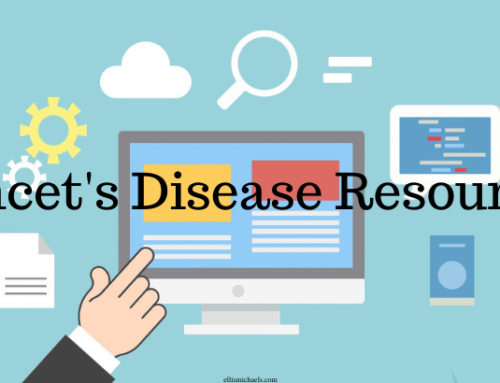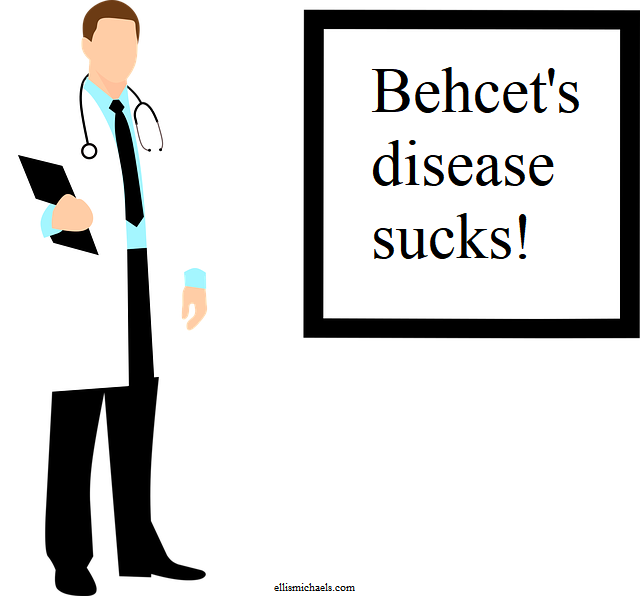If you’ve been diagnosed with Behcet’s disease, you know how much it sucks. Behcet’s can be painful, embarrassing, and just overall sucky. Fortunately, there are a number of home remedies for Behcet’s disease that can significantly reduce your suffering.
In this post, I’m going to tell you about 5 home remedies for Behcet’s disease. These are all substances that I either currently use or have used at some point. They’ve helped me to cope with this lousy illness and I hope they’ll do the same for you.
5 Home Remedies For Behcet’s Disease
Table of Contents
After years of being bounced around from one specialist to the next, I was finally diagnosed with Behcet’s disease in 1997 at the age of sixteen. In the 23 years since then, I’ve tried dozens of home remedies for everything from pain relief to scar removal. In a moment, I’m going to tell you about a few home remedies that have worked for me. But first, let’s define exactly what these are.
According to Merriam-Webster, a home remedy is “a medicine made with ingredients available at home.” But I’m going to offer a slightly different definition: a medicine made with ingredients available without a prescription in stores or online. People have been using home remedies for millennia to treat every ailment you can imagine.
I want to make it clear that I’m not advocating the use of home remedies instead of going to the doctor. You should still keep up with all your regular medical appointments. But I’ve found several of these home remedies to work wonders where prescription drugs have failed. Now, let me tell you about some home remedies for Behcet’s disease.
1. Kratom For Pain (and more)
I’m going to start off this list with a heavy hitter: kratom. This is a plant that grows naturally in several parts of the world. It has been used in traditional medicine for centuries to treat various types of pain (including chronic pain), improve mood, reduce anxiety, and more. The scientific name for kratom is mitragyna speciosa and it belongs to the same family of plants as the coffee bean.1

Kratom plant
Over the past fifteen-or-so years, kratom has become quite popular in the United States and in many other countries around the world. Millions of Americans use it for pain, anxiety, depression, and to reduce opioid use.2 I first discovered kratom about ten years ago. Let me tell you: it’s been a game changer.
The first time I tried kratom, I was blown away by how well it worked. Kratom gave me the same level of pain relief I’d only experienced from prescription opioids – but without all the side effects. From my mid-teens to my mid-twenties, I was on prescription painkillers for the various types of moderate-to-severe pain Behcet’s can cause. But in my late-twenties, I decided to come off opioids and gradually tapered my dosage until I was off them completely.
Over-the-counter (OTC) painkillers like ibuprofen (Advil, Motrin) and acetaminophen (Tylenol) can be great for some types of pain but not others. Personally, I never really found OTC painkillers to help with the chronic pain that often goes hand-in-hand with Behcet’s disease. Kratom, however, does help. And it helps a lot.
After coming off dangerous prescription opioids, I tried a number of home remedies for pain relief. Out of everything I’ve tried, kratom is king. Not only does it greatly reduce pain, it also improves my mood and eliminates excessive anxiety. And unlike prescription opioids, kratom isn’t sedating. In low doses, it actually has a mildly stimulating effect.3
Kratom has interested scientists for nearly a century. Researchers have isolated dozens of unique compounds in the plant, many of which have been shown to have pain-relieving and mood-improving effects. Though kratom and the alkaloids contained within the plant are not opioids, it does act as a partial opioid agonist.4
Prescription opioids like morphine, codeine, oxycodone, and others are full opioid agonists. That means, when ingested, they fully bind to opioid receptors in the brain. Their ability to fully bind to these receptors is what gives opioids such powerful analgesic (pain-reducing) effects. But it’s also what’s responsible for causing their infamous list of side effects including, at high enough doses, respiratory depression and death.
As a partial opioid agonist, kratom has a similar analgesic effect to prescription opioids. But since it does not fully bind to opioid receptors in the brain, kratom isn’t nearly as dangerous. In fact, the risk of overdose death from prescription (and illicit) opioids is more than 1,000 times greater than from kratom.5
While kratom is unquestionably safer than both prescription-and-illegal opioids, like any substance you put in your body, it can have side effects. Personally, I’ve found them to be generally mild and certainly tolerable. Kratom’s side effects can include constipation, nausea, upset stomach, increased heart rate, and irritability.6 I’ve experienced a few of these side effects, but find that kratom’s positive effects greatly outweigh them.
Kratom can be consumed in a variety of ways. Traditionally, its leaves were either chewed and swallowed or used to make kratom tea. While a lot of people still use these methods, I prefer to take kratom in either capsule form or mix ground-up leaves with orange juice. It has a very strong taste which I don’t particularly like. Mixing kratom with OJ or taking it in capsule form makes it much easier for me to consume.
You can find kratom in lots of convenience stores, vape and smoke shops, gas stations, and other brick-and-mortar stores. However, I recommend buying it online. Most kratom products found in brick-and-mortar shops are overpriced. There are several reputable online kratom vendors, but this one is my favorite.
I could go on and on about how much I love using kratom for Behcet’s disease. I’ll write an article just about kratom and Behcet’s at some point. But right now, let’s continue with our list of home remedies for Behcet’s disease.
2. L-Theanine For Anxiety
Anxiety might not be an official symptom of Behcet’s disease, but they often go hand-in-hand. In fact, studies show that people diagnosed with Behcet’s have more anxiety than their healthy counterparts.7 This isn’t at all surprising. How could having a body that attacks itself for no reason not be anxiety provoking?
 From my mid-teens to my mid-twenties, I was prescribed a variety of anxiolytics (anxiety-reducers). The only type of prescription anxiolytic that actually worked were benzodiazepines. These include things like Xanax (alprazolam), Klonopin (clonazepam), Ativan (lorazepam), Valium (diazepam), and many others. While benzos definitely work, they come with a long list of side effects including sedation and rebound anxiety, not to mention they can be highly addictive.
From my mid-teens to my mid-twenties, I was prescribed a variety of anxiolytics (anxiety-reducers). The only type of prescription anxiolytic that actually worked were benzodiazepines. These include things like Xanax (alprazolam), Klonopin (clonazepam), Ativan (lorazepam), Valium (diazepam), and many others. While benzos definitely work, they come with a long list of side effects including sedation and rebound anxiety, not to mention they can be highly addictive.
For many of the same reason I decided to get off prescription opioids, I also stopped taking any benzodiazepines in my mid-to-late twenties. But I needed something for my anxiety. So I tried a number of different substances. Most of them didn’t help at all. However, a couple of them did. One of them is ashwagandha, which we’ll get to next. The other is l-theanine.
L-theanine (often simply called theanine) is a non-essential amino acid found in green tea that was first discovered in 1949. Since then, it’s been the subject of over 500 scientific studies. These studies show that theanine is able to reduce anxiety without causing many of the side effects prescription anxiolytics are notorious for.8 And the Food and Drug Administration (FDA) has given GRAS status. That means they have reviewed the evidence and consider theanine to be generally regarded as safe.9
The first time I tried l-theanine, I didn’t expect very much. At that point, I’d already tried several home remedies for anxiety and none of them really helped. L-theanine, however, did help. While I can’t say it’s 100% as effective as benzos, it definitely cuts my anxiety down by a huge percentage. After taking l-theanine for the first time, the unwanted thoughts that would bounce around in my head almost completely disappeared.
And while theanine’s ability to reduce anxiety is great, that’s not the only thing I like about this non-essential amino acid. I also like that it’s able to do so without making me feel tired and sluggish like benzodiazepines do. Sure, things like Xanax and Ativan knock out my anxiety. But what good is that if they put me to sleep or make me feel like a zombie?
L-theanine is famous for being able to greatly reduce anxiety without being sedating. And you don’t have to worry about all the dangerous side effects (and potentially deadly withdrawal) that go along with benzo use. If anxiety is your primary concern, l-theanine can be a great option. It’s easily available and can even be found at Amazon. But if you’re looking for something that can reduce anxiety and improve mood, you’ll want to check out the next item on our list.
Behcet's Disease Uncensored (BDU) is a podcast to discuss this rare illness.
Behcet's doesn't censor itself when it attacks our bodies. So why should we censor ourselves when discussing it?
Listen to BDU on Spotify or wherever you listen to podcasts.
3. Ashwagandha For Anxiety (and more)
Here we have another plant that has been used in traditional medicine for centuries. Ashwagandha has gone by many names: winter cherry, Indian ginseng, and its species name withania somnifera, among others. Traditionally, ashwagandha has been used for anxiety, stress relief, boosting the immune system, increasing fertility, stopping premature aging, promoting healthy male-hormone levels, improving erectile issues, and more.10
 Modern research is slowly catching up to all the claims about ashwagandha made by traditional medicine. While more research is needed, preliminary studies have been encouraging. They’ve shown that ashwagandha just might do a lot of the the things people have been claiming for centuries. For example, studies have shown ashwagandha to improve infertility11 and boost hormone levels in men.12
Modern research is slowly catching up to all the claims about ashwagandha made by traditional medicine. While more research is needed, preliminary studies have been encouraging. They’ve shown that ashwagandha just might do a lot of the the things people have been claiming for centuries. For example, studies have shown ashwagandha to improve infertility11 and boost hormone levels in men.12
But we’re not here to talk about men’s health. We’re here to talk about using ashwagandha for Behcet’s disease. I’ve found that it helps with anxiety, overall stress, sleep, and maybe even some other issues. But unlike l-theanine, ashwagandha generally doesn’t start working right away. While some people notice a reduction in anxiety after just one dose, for most people it takes at least a couple weeks of daily use to notice ashwagandha’s full benefits.
It’s not just ashwagandha users who claim it can help reduce anxiety, improve sleep, and decrease overall stress. There have been several scientific studies looking into these claims. A 2000 study looked at the effect ashwagandha had on anxiety after six weeks of use.13 Participants were broken up into two groups. One group got ashwagandha and the other got a placebo. After six weeks, 88% of the participants in the ashwagandha group showed significant improvement compared to only 50% of the placebo group.
Other, more-recent studies have also found that ashwagandha can reduce stress and anxiety in adults.14 And some studies show that it can improve sleep and overall quality of life.15 Additionally, these studies all show ashwagandha to be extremely safe. In several of them, the researchers note how well ashwagandha is tolerated.
I’ve used ashwagandha for Behcet’s disease a few times. Whenever I’m feeling chronically stressed, I start taking ashwagandha. And within a week or two, I always feel better. It puts me in a better mood, helps me sleep, and definitely knocks my anxiety down a few pegs. While l-theanine is probably the better option for acute (immediate) stress, ashwagandha works great for chronic stress. You can find ashwagandha on Amazon.
4. Apple Cider Vinegar (ACV) For Skin Symptoms
Of all the home remedies on this list, if you’ve heard of any of them, you’ve heard of this one. Over the past 5-10 years, apple cider vinegar (often referred to as ACV) has gotten a lot of attention. ACV advocates claim in can do everything from help you lose weight to lowering your risk of getting cancer.16 Now, to be clear, I’m not claiming it can do those things. But I can claim that ACV, when used topically (on the skin), has helped me to get rid of several Behcet’s-related skin problems.
 Most of the recent hype surrounding apple cider vinegar involves drinking it daily, often multiple times a day. I’ve never drank ACV and I don’t plan on starting anytime soon. But I have applied it topically to treat a variety of Behcet’s-related skin issues. Sometimes it works wonders. Other times, it doesn’t seem to do much of anything.
Most of the recent hype surrounding apple cider vinegar involves drinking it daily, often multiple times a day. I’ve never drank ACV and I don’t plan on starting anytime soon. But I have applied it topically to treat a variety of Behcet’s-related skin issues. Sometimes it works wonders. Other times, it doesn’t seem to do much of anything.
Maybe 5-6 years ago, I develop a back full of cystic acne. At first, it was just a couple of little lumps. But over the course of a few months, my entire upper back filled up with ugly and often-painful cysts. I went to my primary care physician (PCP) and asked him to put me on an antibiotic. This wasn’t my first bacne experience. Over a decade earlier, I had the same problem. And back then, an antibiotic helped. This time, it didn’t.
After doing a lot of research into topical home remedies, I found a few things that looked promising. In the top two spots: anti-dandruff shampoo (containing ketoconazole) and apple cider vinegar. I tried the shampoo first. After a few weeks, my bacne got a little better – but not enough. So, in addition to the ketoconozole-containing shampoo, I started applying ACV to my back as well. Within days, my back started looking better. I noted that I hadn’t gotten any new acne and what was there began getting better.
Since then I’ve used ACV to treat several skin issues, some Behcet’s related, some not. I’ll tell you about one more. I had a wart in a not-so-great place: I’ll let you use your imagination. Before going to the doctor and having the wart burned off with acid (which was not an appealing idea), I decided to try using apple cider vinegar to get rid of it. For several weeks, I put an ACV-soaked cotton ball on the wart and secured it with medical tape, letting it sit over night. After a month, the wart was completely gone.
Nowadays, whenever I have a new skin problem, ACV is one of the first treatments I consider. There’s no question in my mind that it’s useful for at least a few conditions. However, there hasn’t been much research into ACV’s effect on Behcet’s-related-or-other skin issues. But there has been studies showing that apple cider vinegar does have antibacterial, antifungal, and antiviral properties.17
The only downside of topically using ACV? You end up smelling like vinegar. While I really don’t like the smell, I find it’s a small price to pay for such a safe and effective way to treat a variety of skin conditions. And while my skin is able to tolerate undiluted ACV, a lot of people need to dilute it in water to avoid irritation. You can find apple cider vinegar in grocery stores and on Amazon.
5. Witch Hazel For Skin Symptoms
The last item on our list of home remedies for Behcet’s disease is witch hazel. Known sometimes as winterbloom or by its genus name, Hamamelis, this is a plant that grows naturally in North America and in other parts of the world. It’s been used to treat a wide variety of skin problems in traditional medicine including being used by Native Americans.18
Of all the wonderful home remedies on this list, witch hazel was the last one I discovered. I’ve only been using it for the past couple of years, but I wish I knew about it back in my teens and twenties. It’s been helpful for a number of skin issues including cystic acne, rashes, pimples, and more.
 Witch hazel has been scientifically shown to have anti-inflammatory,19 antioxidant,20 and antiviral effects.21 Additionally, it’s also been shown to reduce itching, redness, pain, and swelling associated with hemorrhoids22 and to reduce skin irritation and sooth sensitive skin.23 So, as you can see, the science community has a lot of good things to say about witch hazel. And the results of that research go a long way in explaining why I’ve had so much success with it.
Witch hazel has been scientifically shown to have anti-inflammatory,19 antioxidant,20 and antiviral effects.21 Additionally, it’s also been shown to reduce itching, redness, pain, and swelling associated with hemorrhoids22 and to reduce skin irritation and sooth sensitive skin.23 So, as you can see, the science community has a lot of good things to say about witch hazel. And the results of that research go a long way in explaining why I’ve had so much success with it.
One Behcet’s symptom I’ve had success treating with witch hazel is cystic acne. Dating back to my mid-teens, I’ve experienced cystic acne on several parts of my body. Throughout half of my high-school career, I’d get big, red, sometimes-golf-ball-sized cysts on my face. Some were painful. All were embarrassing. Fortunately, once I got into my twenties, the facial cysts became less-and-less frequent. But I still get them occasionally.
A few years ago before I discovered witch hazel, I got a big, golf-ball-sized cyst on my right cheek. It was there for months but gradually shrunk until it disappeared. Less than a year ago, another cyst began growing in the same spot. By the time this one appeared, I had discovered witch hazel and decided to apply it to the cyst a few times a day. Within just a couple of days, the cyst stopped growing – and actually began shrinking. A couple weeks later, it was gone completely.
I’ve also used witch hazel for minor acne, rashes, and other mild-to-moderate skin conditions. I find it definitely makes zits and rashes go away quicker. Witch hazel is now my go-to whenever I have skin issues – which is quite often. Behcet’s can cause lots of skin problems and I feel like I’ve had them all. But I also feel like every time Behcet’s couldn’t possibly have any more skin issues to throw at me, a weird rash, lump, bump, or other blemish will appear out of nowhere.
Witch hazel comes as a liquid. Unlike apple cider vinegar which often needs to be diluted, witch hazel can be applied to the skin as-is. Its effect is the opposite of irritating – it’s soothing. Whenever I notice a new pimple or rash somewhere on my body, I splash a little bit of witch hazel on the area a few times a day. It doesn’t always help make them go away faster. But it often does. And witch hazel has never made anything I’ve used it for worse or caused any skin irritation. Like ACV, witch hazel can be found at most grocery stores and at Amazon.
Conclusion
I could write an entire post on any one of these 5 home remedies for Behcet’s disease. At some point, I will for at least a couple of them. Out of the 5 Behcet’s disease home remedies mentioned above, which one(s) would you like to see me write a whole post about?
All of the Behcet’s home remedies I’ve discussed have improved the quality of my life – some significantly so. If you’ve been diagnosed with Behcet’s or another autoimmune disease and are not getting the relief you need from prescription meds, know that there are other options available. Sometimes you have to experiment with a few different things to find what works for you, but it’ll definitely be worth the effort.
Another home remedy that I’ve written about is one I use regularly – but I understand it’s not for everybody. You can read about it here: Cannabis and Behcet’s Disease.
These are only 5 of the dozens of home remedies I’ve tried for Behcet’s disease. There are plenty more and I’ll write about some of them in the future. But for now, I want to know what home remedies for Behcet’s disease you’ve tried. Please leave your answers in the comments section at the bottom. And if you’d like to learn more about how Behcet’s has affected my life, I’ll leave a link to my memoir below:
Finding Happiness Through Pain And Embarrassment: My Life With Behcet’s Disease – A Memoir.
Join the Ellis Michaels mailing list to get notified about new Behcet's disease articles and publications, up-to-date news and info about this rare illness, and more.
References
1Taxonomy: Mitragyna speciosa korth. (2012). U.S. National Plant Germplasm System.
2Garcia-Romeu, A., Cox, D., Smith, K., et al. (2020). Kratom (Mitragyna speciosa): user demographics, use patterns, and implications for the opioid epidemic. Drug & Alcohol Dependence, 208.
3Prozialeck, W., Jivan, J., & Andurkar, S. (2012). Pharmacology of kratom: an emerging botanical agent with stimulant, analgesic and opioid-like effects. Journal of the American Osteopathic Association, 112:782-99.
4Adkins, E., Boyer, J., & McCurdy, C. (2011). Mitragyna speciosa, a psychoactive tree from Southeast Asia with opioid activity. Current Topics in Medicinal Chemistry, 11(9):1165-75.
5Henningfield, J., Grundmann, O., Babin, J., et al. (2019). Risk of death associated with kratom use compared to opioids. Preventative Medicine, 128.
6White, C. (2017). Pharmacologic and clinical assessment of kratom. American Journal of Health-System Pharmacy, 75(5):261-7.
7Sandikci, S., Colak, S., Omma, A., & Enecik, M. (2019). An evaluation of depression, anxiety and fatigue in patients with Behcet’s disease. International Journal of Rheumatic Diseases, 22(6):974-9.
8Sakamoto, F., Ribeiro, R., Bueno, A., et al. (2019). Psychotropic effects of L-theanine and its clinical properties: from the management of anxiety and stress to a potential use in schizophrenia. Pharmacological Research, 174.
9Food and Drug Administration. (2007, Feb. 5). L-theanine GRAS notice.
10Auddy, B., Hazra, J., Mitra, A., et al. (2008). A standardized withania somnifera extract significantly reduces stress-related parameters in chronically stressed humans: a double-blind, randomized, placebo-controlled study. JANA, 11(1):51-7.
11Mahdi, A., Shukla, K., Ahmad, M., et al. (2011). Withania somnifera improves semen quality in stress-related male infertility. Evidence Based Complimentary & Alternative Medicine.
12Ahmad, M., Mahdi, A., Shukla, K., et al. (2010). Withania somnifera improves semen quality by regulating reproductive hormone levels and oxidative stress in seminal plasma of infertile males. Fertility & Sterility, 94(3):989-96.
13Andrade, C., Aswath, A., Chaturvedi, S., et al. (2000). A double-blind, placebo-controlled evaluation of the anxiolytic efficacy of an ethanolic extract of withania somnifera. Indian Journal of Psychiatry, 42(3):295-301.
14Chandrasekhar, K., Kapoor, J., & Anishetty, S. (2012). A prospective, randomized double-blind, placebo-controlled study of safety and efficacy of a high-concentration full-spectrum extract of ashwagandha root in reducing stress and anxiety in adults. Indian Journal of Psychological Medicine, 34(3):255-62.
15Kumar, A., & Kalonia, H. (2008). Effect of withania somnifera on sleep-wake cycle in the sleep-disturbed rats: possible GABAergic mechanism. Indian Journal of Pharmaceutical Sciences, 70(6):806-10.
16Jackob, D. (2020, Sep. 23). 20 benefits of drinking apple cider vinegar. MedicineNet.
17Gopal, J., Anthonydhason, V., Muthu, M., et al. (2019). Authenticating apple cider vinegar’s home remedy claims: antibacterial, antifungal, antiviral properties and cytotoxicity aspect. Natural Products Research, 33(6):906-10.
18Andriote, J. (2012, Nov. 6). The mysterious past and present of witch hazel. The Atlantic.
19Hughes-Formella, B., Filbry, A., Gassmueller, J., & Rippke, F. (2002). Anti-inflammatory efficacy of topical preparations with 10% hamamelis distillate in a UV erythema test. Skin Pharmacology & Applied Skin Physiology, 15(2):125-32.
20Thring, T., Hili, P., & Naughton, D. (2011). Antioxidant and potential anti-inflammatory activity of extracts and formulations of white tea, rose, and witch hazel on primary human dermal fibroblast cells. Journal of Inflammation (London), 8:27.
21Theisen, L., Erdelmeier, C., Spoden, G., et al. (2014). Tannins from Hamamelis virginiana bark extract: characterization and improvement of the antiviral efficacy against influenza A virus and human papillomavirus. PLoS One, 9(1).
22MacKay, D. (2001). Hemorrhoids and varicose veins: a review of treatment options. Alternative Medicine Review, 6(2):126-40.
23Heinicke, I., Adams, D., Barnes, T., & Greive, K. (2015). Evaluation of a topical treatment for the relief of sensitive skin. Clinical, Cosmetic, & Investigational Dermatology, 8:405-12.








Loving all of this helpful content. I’ve been diagnosed with Behçet’s for about 15 years now.
Mine BD has skin involvement with erythema nodosum. I learned about aluminum acetate topical ointment. I have been applying it to new nodules and it is amazing how quickly the swelling goes down and changes color to the shade right before it goes away. Two days! I also have been using it for boils in unsavory spots 😂 and it also seems to be helping with that. Thanks for all of this content. I don’t feel alone. ❤️
Thank you so much for the kind words! I’m sorry I’m only seeing this now. I hope you’ve been well since May. And I’m glad the ointment is helpful!
I have BD as well i get A lot of ulcers and they are so painful any recommendations on how to treat them?